

Some endangered animals, like Pandas, receive worldwide attention while others, like the Blue Fin Tuna, do not receive the same amount of publicity
EXTINCT IN THE WILD: living specimens can only be found in captivity
EXTINCT: the species has disappeared from the face of the Earth. Bears. Chimpanzees. Endangered Birds. Gorillas. Orangutans. Rhinoceros. Sea Turtles. Snow Leopards. Tigers. First U.S. Bumblebee Officially Listed as Endangered. It’s official: For the first time in the United States, a bumblebee species has been declared endangered.

The rusty patched bumblebee (Bombus affinis), once a common sight, is “now balancing precariously on the brink of extinction,” according to the U.S. Fish and Wildlife Service. RARE: Portraits of America's Endangered Species. Shocking Study Finds Lions are Nearly Extinct in West Africa. Physically and emotionally demanding.

That’s how Philipp Henschel, Lion Program Survey Coordinator for the big-cat conservation organization Panthera, describes the six years he and other researchers spent combing the wilds of 17 nations looking for the elusive and rarely studied West African lion. The results of their quest were disheartening to say the least. Back in 2005, before the survey began, West African lions were believed to live in 21 different protected areas. But now a paper about the survey, published today in PLoS One, confirms that lions actually exist in just four of those sites.
Worse still, the researchers estimate that the total population for West African lions is only about 400 animals, including fewer than 250 mature individuals of breeding age. Iberian Lynx, Most Endangered Wild Cat. (ENDANGERED SPECIES) Hope for the world’s most endangered wild cat, the Iberian lynx, has arrived!
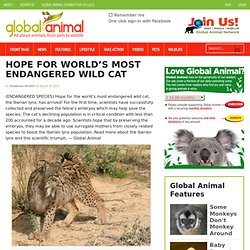
For the first time, scientists have successfully collected and preserved the feline’s embryos which may help save the species. The cat’s declining population is in critical condition with less than 200 accounted for a decade ago. Australian mammals on brink of extinction calamity. 10 February 2015Last updated at 07:58 ET By Helen Briggs Environment Correspondent The endangered northern quoll, a mammal species native to Australia Australia has lost one in ten of its native mammals species over the last 200 years in what conservationists describe as an "extinction calamity".
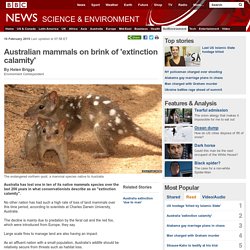
Adult and baby Gharials (BBC) Cats are going extinct: 12 most endangered feline species. Today, May 17th, is Endangered Species Day.
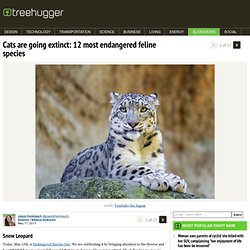
We are celebrating it by bringing attention to the diverse and beautiful felid species around the world that are in danger of becoming extinct. The following species are either currently listed as endangered or vulnerable. We hope that by learning about these amazing relatives of our well-loved domestic cats, readers will be encouraged to act to protect these species. First up is the well-known snow leopard. The most endangered predator in Asia, the Dhole. Scottish Wildcat Association. Saola Caught in Asia. 16 September 2010Last updated at 14:59 By Katia Moskvitch Science reporter, BBC News There may only be a few dozen of Saola left in the wild An extremely rare animal known as the "Asian unicorn" - in spite of having two horns - has been caught by villagers in Laos.
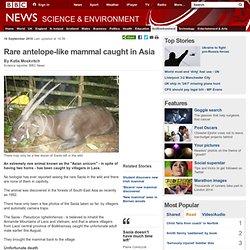
No biologist has ever reported seeing the rare Saola in the wild and there are none of them in captivity. The animal was discovered in the forests of South-East Asia as recently as 1992. There have only been a few photos of the Saola taken so far, by villagers and automatic camera traps. The Saola - Pseudoryx nghetinhensis - is believed to inhabit the Annamite Mountains of Laos and Vietnam, and that is where villagers from Laos' central province of Bolikhamxay caught the unfortunate adult male earlier this August. Amur leopard cub is born in Germany. The birth of an Amur leopard cub at Germany's Leipzig Zoo is huge news for her species, which is critically endangered.
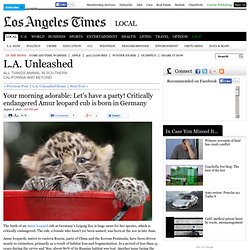
The cub, a female who hasn't yet been named, was born at the zoo in late June. Amur leopards, native to eastern Russia, parts of China and the Korean Peninsula, have been driven nearly to extinction, primarily as a result of habitat loss and fragmentation. In a period of less than 15 years during the 1970s and '80s, about 80% of its Russian habitat was lost. Another issue facing the species is poaching, since their impressively patterned coats fetch high prices on the black market.
Today, it's estimated that fewer than 40 Amur leopards remain in the wild in Russia, and an even smaller number are thought to remain in China. See more photos of the Leipzig Zoo's cub after the jump. RELATED CUTE CUBS: Your morning adorable: Clouded leopard cubs make their debut at Paris zoo Your morning adorable: Lion cubs get a checkup at Israeli zoo. The Rate of Extinction: 3 Species per Hour. About 6 waves of massive extinction are known in the history of the Earth.
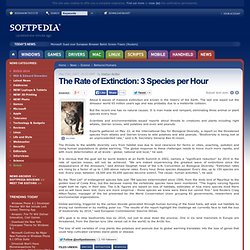
The last one wiped out the dinosaur world 65 million years ago and was probably due to a meteorite collision. But the recent one has no natural causes. Przewalski's horse.